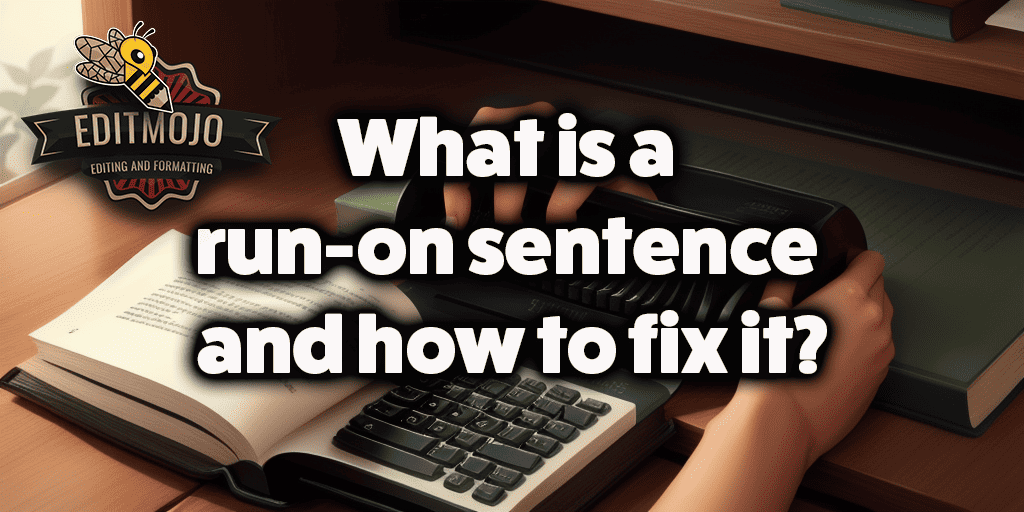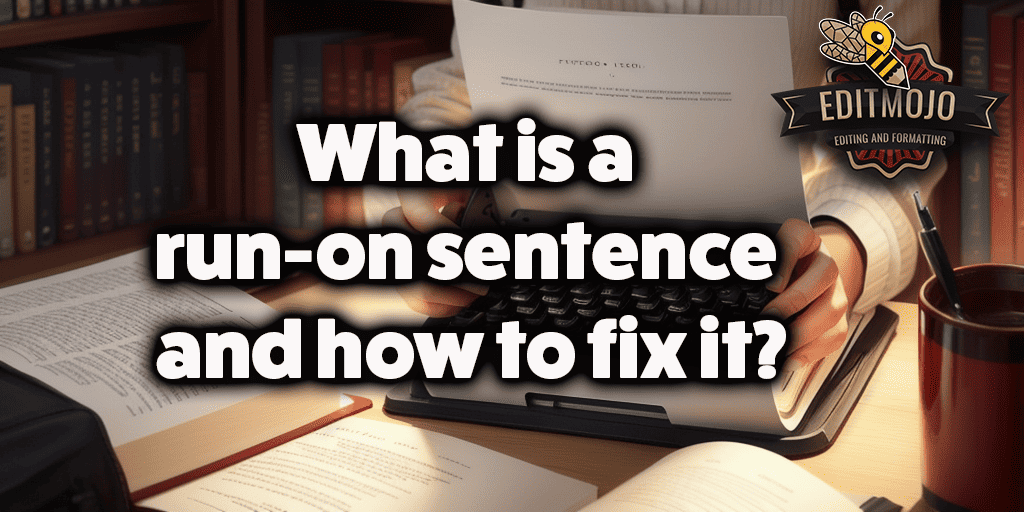What is a Run-on Sentence and How to Fix It?
What is a run-on sentence and how to fix it?
“The commas are the signposts leading the reader through the labyrinth of your sentence. Omit one, and your reader is likely to get lost.” – Unknown
Run-on sentences are like the marathoners of the grammatical world. They just keep running, and running, and running. They are long-winded, exhausting, and often confusing. But what exactly is a run-on sentence and how can we go about fixing it? Let’s break it down.
Understanding Run-on Sentences
A run-on sentence occurs when two or more independent clauses (complete sentences) are connected improperly. It’s not about the length of the sentence, but rather about the punctuation and linkage of ideas. Grammarly provides a succinct definition of a run-on sentence.
Consider the following example:
“I love reading books I spend hours every day doing it.”
At first glance, this might just seem like a long sentence, but it’s actually a run-on. Why? Because there are two complete thoughts, each with its subject and predicate: “I love reading books” and “I spend hours every day doing it”. They are ‘running on’ into each other without proper punctuation or conjunctions.

How to Spot and Fix Run-on Sentences (grammar)
Now that we understand what a run-on sentence is, let’s explore how to spot and correct them. This will not only make your writing more precise and easier to read but also increase its Google readability score, an essential factor in SEO ranking.
1. Use a Period
The simplest way to fix a run-on sentence is by breaking it into two separate sentences using a period.
Example:
“I love reading books. I spend hours every day doing it.”
2. Use a Comma and a Coordinating Conjunction
If the two independent clauses are closely related, you might prefer to keep them together. In this case, use a comma followed by a coordinating conjunction (and, but, for, nor, yet, or, so).
Example:
“I love reading books, and I spend hours every day doing it.”

3. Use a Semicolon
If the two independent clauses are closely related and you want to avoid using a coordinating conjunction, you can use a semicolon. It acts as a sort of ‘soft period’ that shows a close relationship between the clauses.
Example:
“I love reading books; I spend hours every day doing it.”
It’s important to remember that not all long sentences are run-on sentences. Long sentences can be perfectly grammatical if they are structured correctly. The issue with run-on sentences is that they can make your writing hard to follow. By learning to identify and correct run-on sentences, you can make your writing clearer and more effective.
Run-on Sentences: The Bottom Line
Grammar may seem like a small detail, but it’s the foundation of effective communication. By mastering concepts like run-on sentences, you can enhance your writing, improve readability, and ultimately, connect better with your readers.
For more comprehensive lessons on improving your writing, check out courses like Grammar and Punctuation on Coursera or Writing and Editing: Word Choice and Word Order on LinkedIn Learning.
Remember, the road to writing mastery is paved with practice and a strong grasp of the basics. And while run-on sentences can sometimes seem like a minor issue, they can make a significant difference in the quality and readability of your work.

Practicing With Run-on Sentences
Want to sharpen your skills in spotting and fixing run-on sentences? Try this fun exercise: Take a piece of your writing or a page from a book and look for any run-on sentences. Then, practice correcting them using the methods discussed above.
Example:
Run-on sentence:
“I’m a fan of sci-fi novels they transport me to other worlds.”
Corrected versions:
- Using a period: “I’m a fan of sci-fi novels. They transport me to other worlds.”
- Using a comma and a coordinating conjunction: “I’m a fan of sci-fi novels, for they transport me to other worlds.”
- Using a semicolon:
> “I’m a fan of sci-fi novels; they transport me to other worlds.”
In Conclusion
Writing doesn’t have to be a race. There’s no need to rush thoughts or ideas. By taking the time to properly structure your sentences, you can provide your readers with a smoother, more enjoyable reading experience.
So, the next time you’re writing, watch out for those run-on sentences! With a little practice and careful editing, you can make your writing more clear, concise, and engaging.
As author Thomas Mann once said, “A writer is someone for whom writing is more difficult than it is for other people.” But remember, every challenge is a stepping stone to becoming a better writer.
Happy writing!
For more writing tips and tricks, be sure to check out our other blog posts on Grammar and Punctuation.
Here are several examples of run-on sentences, along with their corrected versions:
- Run-on: “I’m not a morning person I struggle to wake up early.”
- Corrected: “I’m not a morning person. I struggle to wake up early.”
- Corrected: “I’m not a morning person; I struggle to wake up early.”
- Corrected: “I’m not a morning person, so I struggle to wake up early.”
- Run-on: “She loves painting it’s her favorite hobby.”
- Corrected: “She loves painting. It’s her favorite hobby.”
- Corrected: “She loves painting; it’s her favorite hobby.”
- Corrected: “She loves painting, as it’s her favorite hobby.”
- Run-on: “It’s raining outside I forgot my umbrella.”
- Corrected: “It’s raining outside. I forgot my umbrella.”
- Corrected: “It’s raining outside; I forgot my umbrella.”
- Corrected: “It’s raining outside, and I forgot my umbrella.”
- Run-on: “He is an excellent guitarist his band is very popular.”
- Corrected: “He is an excellent guitarist. His band is very popular.”
- Corrected: “He is an excellent guitarist; his band is very popular.”
- Corrected: “He is an excellent guitarist, and his band is very popular.”
- Run-on: “They missed the train they had to wait for the next one.”
- Corrected: “They missed the train. They had to wait for the next one.”
- Corrected: “They missed the train; they had to wait for the next one.”
- Corrected: “They missed the train, so they had to wait for the next one.”
- Run-on: “She didn’t study for the test she didn’t understand the material.”
- Corrected: “She didn’t study for the test. She didn’t understand the material.”
- Corrected: “She didn’t study for the test; she didn’t understand the material.”
- Corrected: “She didn’t study for the test, hence she didn’t understand the material.”
Remember, the key to correcting a run-on sentence is to properly separate two independent clauses. You can do this by using a period, a semicolon, or a comma with a coordinating conjunction (for, and, nor, but, or, yet, so).
